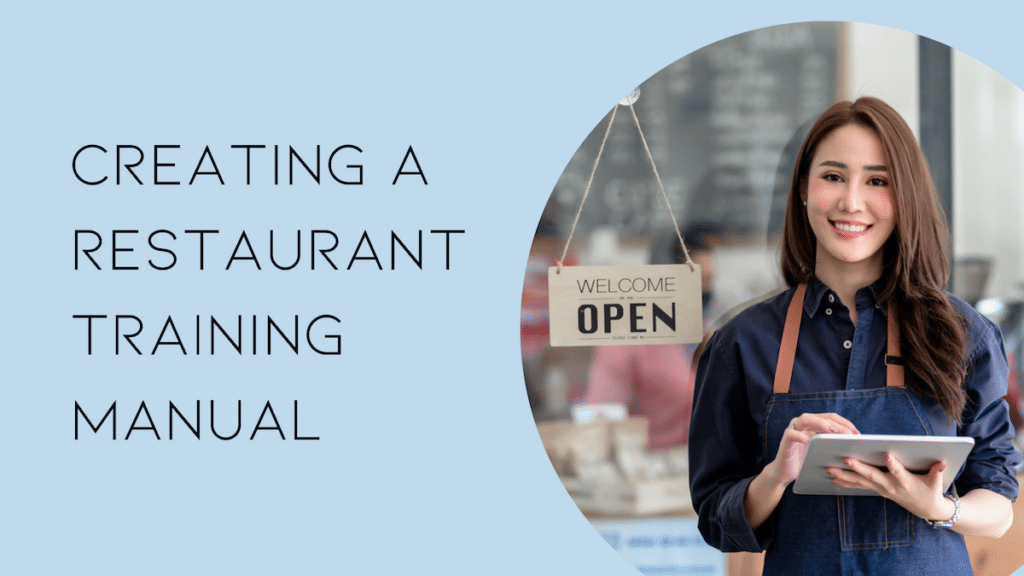Updated on: February 9, 2025
Creating a training manual for your manager training program will be a completely different process from one organization to the next. However, the outline generally remains the same, with different specifics depending on your brand. Managers need to understand the restaurant employee training manual backward and forward to ensure thorough training and help them manage employees. Your restaurant training manual is often the very first real exposure a new employee has to your brand and organization, so it should be developed and delivered with consideration and care.
Why a Restaurant Training Manual Is Vital
Your restaurant training manual is the go-to resource for everything your employees need to keep the business running daily. Your store and shift managers will be the leaders in your teams. Unfortunately, their knowledge and experience will only be available for as long as they are. Your restaurant training manual is absolutely vital to running a successful restaurant that lasts.
Here are some of the most notable reasons why your training manual is vital:
- Clear and consistent training: It gives your team a clear structure to your restaurant training program, especially during onboarding. It helps new employees feel more secure and confident in their choice to work for your company. This makes your training more consistent and standardized for each employee across all of your locations.
- Reference and repetition: It contains documented material that can be referred to at any time and ensures that essential training topics and steps aren’t overlooked. As every student and teacher knows, some things will not be retained after the first teaching. This is also true in the restaurant industry. The restaurant training manual allows repetition and reference for training employees and creating a positive work environment.
- Communicate your brand: The training manual is also a great opportunity to clearly state what is important to your brand and make your expectations, rules, and processes uniform across all your locations.
- Improve customer service: Restaurant owners can improve customer service when their training manual ensures all employees know the menu, the restaurant’s policies, and customer interaction expectations. By having a clear and comprehensive training manual, restaurants can help ensure their employees are well-equipped to provide high-quality customer service.

What to Include In Your Restaurant Training Manual
Of course, the specific information provided in the training manual will be unique to your organization. Your organization’s leaders should carefully consider each point and compile it into a resource for sharing your vision with new and existing employees.
Restaurant Story
How did your restaurant start? What’s your brand story? Including this information gives your employees the building blocks of company culture to rally around.
Mission Statement
What’s the overall goal of your restaurant? What is the primary focus of the business, and what experience are you looking to create for your customers? A mission statement makes sharing this with restaurant staff and new employees easy, improving the guest experience.
Guest and Customer Service Principles
This includes how you expect your guests to be treated. How do you want them greeted? How will you handle customer complaints? What can you emphasize to improve customer satisfaction? Make a list of principles and values to focus on when your staff interacts with customers.
Dress Code
Not every restaurant has uniforms. However, at minimum, there are expectations regarding attire. These include specific styles, shoes, and color coordination. It’s important also to create a list of items that are never acceptable under any circumstances.
Food and Kitchen Safety Requirements
This section outlines the safe operation, food preparation, and proper use of equipment. Protocols for knives and other sharp instruments are included, but a heavy focus should be placed on safe food storage, proper heating temperatures, and cold storage.
HR Procedures and Policies
This gives employees information regarding how to conduct themselves and where to turn if there are any issues between them or management. HR-related matters normally include time off, emergencies, conduct amongst the workforce, and general conduct/participation expectations. This should inform your team about what to do, how to handle any issues they have, and the HR process.
General Pay and Benefits Information
Pay styles (shift, salary, hourly, etc.) should be listed here. You don’t have to go into specific amounts – just touch on general options based on roles. If your restaurant includes insurance, 401K, stock options, or other benefits, this should be included in this section. This section also includes specific information regarding compensation for your servers. For instance, many new wait staff members will ask, “Are tips taxable?” It’s important to provide a clear answer to this inquiry.

Revising and Updating Your Restaurant Training Manual
Changing the manual is important for the growth of your restaurant business. Continue to make updates and changes to your training manual as your team grows; new processes are implemented, and new ideas or problems to solve appear through the experience of running your restaurant locations. Here are a few tips to ensure that your restaurant training manual is up-to-date and continues to provide additional benefits over time.
Regularly review and revise your training manual
Set aside a specific time regularly to review your restaurant training manual. We recommend gathering your team at least once a year to read through the manual’s materials and note where changes are needed. As your organization expands to more locations, you’ll gain a lot more feedback and experience and may need to revise things more frequently, like every six months. Your HR department may also need to make adjustments on an ongoing basis.
Ask for feedback from employees
The best source of inspiration for updating and improving your training manual is actively seeking feedback from your team. This is especially true when onboarding new employees and getting them up to speed, as the training manual will be something they are reading through and referencing all the time. If you haven’t already, make sure that your onboarding process includes a step that specifically asks how well your training manual answered the questions of your new hire and if they have any feedback for improving it. You may even want to let them know at the beginning of training to watch out for things that could be improved.
Utilize restaurant HR software to manage your training manual
While there’s nothing inherently wrong with an ink-and-paper printed training manual, you can save time and effort by utilizing a digital version through restaurant HR software. This software can be incredibly useful for keeping updated versions of your manual, or even specific chapters or sections of your manual individually, in a place that can be accessed and referenced from anywhere and at any time.
Restaurant HR software can also help you create onboarding and training documents and checklists that ensure each employee is up-to-date on their training and that no important topics are missed. This can be especially useful when you manage the training of new employees across many locations, saving your HR department a lot of time and energy in tracking each new employee’s progress.
By regularly reviewing and updating the training manual, managers can help ensure that all employees have the most current and accurate information, which can improve the restaurant’s overall operation.
Additional Topics for Your Restaurant Training Program
Your restaurant training program will likely cover a wide range of topics and can be implemented in as many ways as possible. Check out more of our training program resources to make the most of your restaurant training program:
- Methods for Training Employees in Restaurants: Pros, Cons, and Tools
- Restaurant Employee Onboarding: How-to and Common Topics
- Role-Specific Restaurant Training in Quick-Service and Fast Casual Restaurants
- Continuing Restaurant Training After Onboarding
- Additional Training Topics for Restaurant Employees






